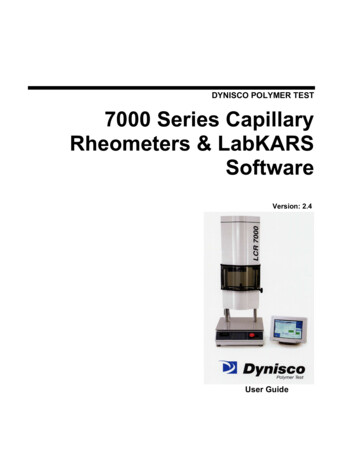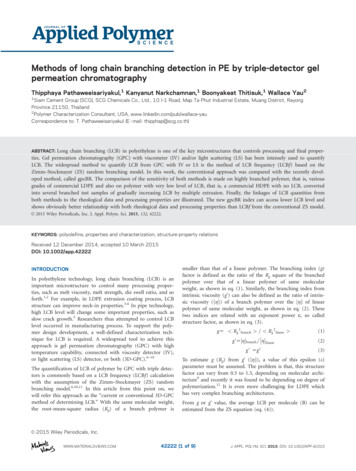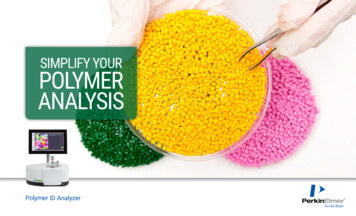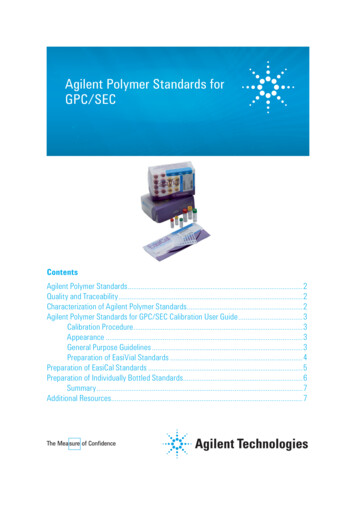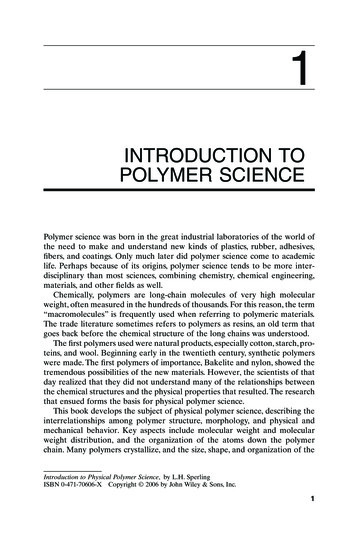
Transcription
1INTRODUCTION TOPOLYMER SCIENCEPolymer science was born in the great industrial laboratories of the world ofthe need to make and understand new kinds of plastics, rubber, adhesives,fibers, and coatings. Only much later did polymer science come to academiclife. Perhaps because of its origins, polymer science tends to be more interdisciplinary than most sciences, combining chemistry, chemical engineering,materials, and other fields as well.Chemically, polymers are long-chain molecules of very high molecularweight, often measured in the hundreds of thousands. For this reason, the term“macromolecules” is frequently used when referring to polymeric materials.The trade literature sometimes refers to polymers as resins, an old term thatgoes back before the chemical structure of the long chains was understood.The first polymers used were natural products, especially cotton, starch, proteins, and wool. Beginning early in the twentieth century, synthetic polymerswere made. The first polymers of importance, Bakelite and nylon, showed thetremendous possibilities of the new materials. However, the scientists of thatday realized that they did not understand many of the relationships betweenthe chemical structures and the physical properties that resulted. The researchthat ensued forms the basis for physical polymer science.This book develops the subject of physical polymer science, describing theinterrelationships among polymer structure, morphology, and physical andmechanical behavior. Key aspects include molecular weight and molecularweight distribution, and the organization of the atoms down the polymerchain. Many polymers crystallize, and the size, shape, and organization of theIntroduction to Physical Polymer Science, by L.H. SperlingISBN 0-471-70606-X Copyright 2006 by John Wiley & Sons, Inc.1
2CHAIN STRUCTURE AND CONFIGURATIONcrystallites depend on how the polymer was crystallized. Such effects asannealing are very important, as they have a profound influence on the finalstate of molecular organization.Other polymers are amorphous, often because their chains are too irregular to permit regular packing. The onset of chain molecular motion heralds theglass transition and softening of the polymer from the glassy (plastic) state tothe rubbery state. Mechanical behavior includes such basic aspects as modulus,stress relaxation, and elongation to break. Each of these is relatable to thepolymer’s basic molecular structure and history.This chapter provides the student with a brief introduction to the broaderfield of polymer science. Although physical polymer science does not includepolymer synthesis, some knowledge of how polymers are made is helpful inunderstanding configurational aspects, such as tacticity, which are concernedwith how the atoms are organized along the chain. Similarly polymer molecular weights and distributions are controlled by the synthetic detail. Thischapter starts at the beginning of polymer science, and it assumes no priorknowledge of the field.1.1FROM LITTLE MOLECULES TO BIG MOLECULESThe behavior of polymers represents a continuation of the behavior of smallermolecules at the limit of very high molecular weight. As a simple example,consider the normal alkane hydrocarbon opaneThese compounds have the general structureHCH2nH(1.2)where the number of —CH2— groups, n, is allowed to increase up to severalthousand. The progression of their state and properties is shown in Table 1.1.At room temperature, the first four members of the series are gases.n-Pentane boils at 36.1 C and is a low-viscosity liquid. As the molecular weightof the series increases, the viscosity of the members increases. Although commercial gasolines contain many branched-chain materials and aromatics aswell as straight-chain alkanes, the viscosity of gasoline is markedly lower thanthat of kerosene, motor oil, and grease because of its lower average chainlength.These latter materials are usually mixtures of several molecular species,although they are easily separable and identifiable. This point is important
1.1Table 1.1FROM LITTLE MOLECULES TO BIG MOLECULES3Properties of the alkane/polyethylene seriesNumber of Carbonsin ChainState and Properties �5050–10001000–50003–6 105Simple gasSimple liquidMedium-viscosity liquidHigh-viscosity liquidCrystalline solidSemicrystalline solidTough plastic solidFibersBottled gas for cookingGasolineKeroseneOil and greaseParaffin wax candlesMilk carton adhesives and coatingsPolyethylene bottles and containersSurgical gloves, bullet-proof vestsbecause most polymers are also “mixtures”; that is, they have a molecularweight distribution. In high polymers, however, it becomes difficult to separateeach of the molecular species, and people talk about molecular weightaverages.Compositions of normal alkanes averaging more than about 20 to 25 carbonatoms are crystalline at room temperature. These are simple solids known aswax. It must be emphasized that at up to 50 carbon atoms the material is farfrom being polymeric in the ordinary sense of the term.The polymeric alkanes with no side groups that contain 1000 to 3000 carbonatoms are known as polyethylenes. Polyethylene has the chemical structureCH2CH2n(1.3)which originates from the structure of the monomer ethylene, CH2 CH2. Thequantity n is the number of mers—or monomeric units in the chain. In someplaces the structure is writtenCH2n (1.4)or polymethylene. (Then n 2n.) The relationship of the latter structure tothe alkane series is clearer. While true alkanes have CH3— as end groups, mostpolyethylenes have initiator residues.Even at a chain length of thousands of carbons, the melting point of polyethylene is still slightly molecular-weight-dependent, but most linear polyethylenes have melting or fusion temperatures, Tf, near 140 C. The approach tothe theoretical asymptote of about 145 C at infinite molecular weight (1) isillustrated schematically in Figure 1.1.The greatest differences between polyethylene and wax lie in their mechanical behavior, however. While wax is a brittle solid, polyethylene is a toughplastic. Comparing resistance to break of a child’s birthday candle with a washbottle tip, both of about the same diameter, shows that the wash bottle tip canbe repeatedly bent whereas the candle breaks on the first deformation.
4CHAIN STRUCTURE AND CONFIGURATIONFigure 1.1 The molecular weight-melting temperature relationship for the alkane series.An asymptotic value of about 145 C is reached for very high molecular weight linearpolyethylenes.Polyethylene is a tough plastic solid because its chains are long enough toconnect individual stems together within a lamellar crystallite by chain folding(see Figure 1.2). The chains also wander between lamellae, connecting severalof them together. These effects add strong covalent bond connections bothwithin the lamellae and between them. On the other hand, only weak van derWaals forces hold the chains together in wax.In addition a certain portion of polyethylene is amorphous. The chains inthis portion are rubbery, imparting flexibility to the entire material. Wax is100% crystalline, by difference.The long chain length allows for entanglement (see Figure 1.3). The entanglements help hold the whole material together under stress. In the melt state,chain entanglements cause the viscosity to be raised very significantly also.The long chains shown in Figure 1.3 also illustrate the coiling of polymerchains in the amorphous state. One of the most powerful theories in polymerscience (2) states that the conformations of amorphous chains in space arerandom coils; that is, the directions of the chain portions are statisticallydetermined.1.2 MOLECULAR WEIGHT AND MOLECULARWEIGHT DISTRIBUTIONSWhile the exact molecular weight required for a substance to be called apolymer is a subject of continued debate, often polymer scientists put thenumber at about 25,000 g/mol. This is the minimum molecular weight requiredfor good physical and mechanical properties for many important polymers.This molecular weight is also near the onset of entanglement.1.2.1Effect on Tensile StrengthThe tensile strength of any material is defined as the stress at break duringelongation, where stress has the units of Pa, dyn/cm2, or lb/in2; see Chapter 11.
1.2Figure 1.2MOLECULAR WEIGHT AND MOLECULAR WEIGHT DISTRIBUTIONS5Comparison of wax and polyethylene structure and morphology.The effect of molecular weight on the tensile strength of polymers is illustratedin Figure 1.4. At very low molecular weights the tensile stress to break, sb, isnear zero. As the molecular weight increases, the tensile strength increasesrapidly, and then gradually levels off. Since a major point of weakness at themolecular level involves the chain ends, which do not transmit the covalentbond strength, it is predicted that the tensile strength reaches an asymptotic
6CHAIN STRUCTURE AND CONFIGURATION(a)(b)Figure 1.3 Entanglement of polymer chains. (a) Low molecular weight, no entanglement.(b) High molecular weight, chains are entangled. The transition between the two is often atabout 600 backbone chain atoms.Figure 1.4 Effect of polymer molecular weight on tensile strength.value at infinite molecular weight. A large part of the curve in Figure 1.4 canbe expressed (3,4)sb A -BMn(1.5)where Mn is the number-average molecular weight (see below) and A and Bare constants. Newer theories by Wool (3) and others suggest that more than90% of tensile strength and other mechanical properties are attained whenthe chain reaches eight entanglements in length.1.2.2Molecular Weight AveragesThe same polymer from different sources may have different molecularweights. Thus polyethylene from source A may have a molecular weight of150,000 g/mol, whereas polyethylene from source B may have a molecularweight of 400,000 g/mol (see Figure 1.5). To compound the difficulty, allcommon synthetic polymers and most natural polymers (except proteins) havea distribution in molecular weights. That is, some molecules in a given sample
1.2Figure 1.5A and B.MOLECULAR WEIGHT AND MOLECULAR WEIGHT DISTRIBUTIONS7Molecular weight distributions of the same polymer from two different sources,of polyethylene are larger than others. The differences result directly from thekinetics of polymerization.However, these facts led to much confusion for chemists early in the twentieth century. At that time chemists were able to understand and characterizesmall molecules. Compounds such as hexane all have six carbon atoms. Ifpolyethylene with 2430 carbon atoms were declared to be “polyethylene,” howcould that component having 5280 carbon atoms also be polyethylene? Howcould two sources of the material having different average molecular weightsboth be polyethylene, noting A and B in Figure 1.5?The answer to these questions lies in defining average molecular weightsand molecular weight distributions (5,6). The two most important molecularweight averages are the number-average molecular weight, Mn,Mn ÂNMÂNiii(1.6)iiwhere Ni is the number of molecules of molecular weight Mi, and the weightaverage molecular weight, Mw,Mw ÂNMÂNMii2iiii(1.7)For single-peaked distributions, Mn is usually near the peak. The weightaverage molecular weight is always larger. For simple distributions, Mw maybe 1.5 to 2.0 times Mn. The ratio Mw/Mn, sometimes called the polydispersityindex, provides a simple definition of the molecular weight distribution. Thusall compositions of CH2 CH2 n are called polyethylene, the molecularweights being specified for each specimen.For many polymers a narrower molecular distribution yields better properties. The low end of the distribution may act as a plasticizer, softening thematerial. Certainly it does not contribute as much to the tensile strength. Thehigh-molecular-weight tail increases processing difficulties, because of its enor-
8CHAIN STRUCTURE AND CONFIGURATIONmous contribution to the melt viscosity. For these reasons, great emphasis isplaced on characterizing polymer molecular weights.1.3MAJOR POLYMER TRANSITIONSPolymer crystallinity and melting were discussed previously. Crystallization isan example of a first-order transition, in this case liquid to solid. Most smallmolecules crystallize, an example being water to ice. Thus this transition is veryfamiliar.A less classical transition is the glass–rubber transition in polymers. At theglass transition temperature, Tg, the amorphous portions of a polymer soften.The most familiar example is ordinary window glass, which softens and flowsat elevated temperatures. Yet glass is not crystalline, but rather it is an amorphous solid. It should be pointed out that many polymers are totallyamorphous. Carried out under ideal conditions, the glass transition is a typeof second-order transition.The basis for the glass transition is the onset of coordinated molecularmotion is the polymer chain. At low temperatures, only vibrational motionsare possible, and the polymer is hard and glassy (Figure 1.6, region 1) (7). Inthe glass transition region, region 2, the polymer softens, the modulus dropsthree orders of magnitude, and the material becomes rubbery. Regions 3, 4,and 5 are called the rubbery plateau, the rubbery flow, and the viscous flowregions, respectively. Examples of each region are shown in Table 1.2.Figure 1.6 Idealized modulus–temperature behavior of an amorphous polymer. Young’smodulus, stress/strain, is a measure of stiffness.
1.3Table 1.29Typical polymer viscoelastic behavior at room temperature (7a)RegionGlassyGlass transitionRubbery plateauRubbery flowViscous flowaMAJOR POLYMER TRANSITIONSPolymerPoly(methyl methacrylate)Poly(vinyl leaPoly(dimethylsiloxane)ApplicationPlasticLatex paintRubber bandsChewing gumLubricantFrom the latex of Achras sapota, a mixture of cis- and trans-polyisoprene plus polysaccharides.Figure 1.7 Stress–strain behavior of various polymers. While the initial slope yields themodulus, the area under the curve provides the energy to fracture.Depending on the region of viscoelastic behavior, the mechanical properties of polymers differ greatly. Model stress–strain behavior is illustrated inFigure 1.7 for regions 1, 2, and 3. Glassy polymers are stiff and often brittle,breaking after only a few percent extension. Polymers in the glass transitionregion are more extensible, sometimes exhibiting a yield point (the hump inthe tough plastic stress–strain curve). If the polymer is above its brittle–ductiletransition, Section 11.2.3, rubber-toughened, Chapter 13, or semicrystallinewith its amorphous portions above Tg, tough plastic behavior will also beobserved. Polymers in the rubbery plateau region are highly elastic, oftenstretching to 500% or more. Regions 1, 2, and 3 will be discussed further inChapters 8 and 9. Regions 4 and 5 flow to increasing extents under stress; seeChapter 10.Cross-linked amorphous polymers above their glass transition temperaturebehave rubbery. Examples are rubber bands and automotive tire rubber. Ingeneral,Young’s modulus of elastomers in the rubbery-plateau region is higherthan the corresponding linear polymers, and is governed by the relationE 3nRT, in Figure 1.6 (line not shown); the linear polymer behavior isillustrated by the line (b). Here, n represents the number of chain segmentsbound at both ends in a network, per unit volume. The quantities R and T arethe gas constant and the absolute temperature, respectively.Polymers may also be partly crystalline. The remaining portion of thepolymer, the amorphous material, may be above or below its glass transition
10CHAIN STRUCTURE AND CONFIGURATIONTable 1.3 Examples of polymers at room temperature by transition behaviorAbove TgBelow TgCrystallineAmorphousPolyethyleneCelluloseNatural rubberPoly(methyl methacrylate)temperature, creating four subclasses of materials. Table 1.3 gives a commonexample of each.While polyethylene and natural rubber need no further introduction, common names for processed cellulose are rayon and cellophane.Cotton is nearly pure cellulose, and wood pulp for paper is 80 to 90% cellulose. A well-known trade name for poly(methyl methacrylate) is Plexiglas .The modulus–temperature behavior of polymers in either the rubbery-plateauregion or in the semicrystalline region are illustrated further in Figure 8.2,Chapter 8.Actually there are two regions of modulus for semicrystalline polymers. Ifthe amorphous portion is above Tg, then the modulus is generally betweenrubbery and glassy. If the amorphous portion is glassy, then the polymer willbe actually be a bit stiffer than expected for a 100% glassy polymer.1.41.4.1POLYMER SYNTHESIS AND STRUCTUREChain PolymerizationPolymers may be synthesized by two major kinetic schemes, chain and stepwise polymerization. The most important of the chain polymerization methodsis called free radical polymerization.1.4.1.1 Free Radical Polymerization The synthesis of poly(ethyl acrylate) will be used as an example of free radical polymerization. Benzoyl peroxide is a common initiator. Free radical polymerization has three majorkinetic steps—initiation, propagation, and termination.1.4.1.2 Initiationfree radicals:On heating, benzoyl peroxide decomposes to give twoOOCO:O CBenzoyl peroxideOD2CO.(1.8)Free radical, R .In this reaction the electrons in the oxygen–oxygen bond are unpaired andbecome the active site. With R representing a generalized organic chemical
1.4POLYMER SYNTHESIS AND STRUCTURE11group, the free radical can be written R·. (It should be pointed out that hydrogen peroxide undergoes the same reaction on a wound, giving a burning sensation as the free radicals “kill the germs.”)The initiation step usually includes the addition of the first monomermolecule:HR . CH2COCFree radicalHROCH2C2H5OEthyl acrylateC.C(1.9)OC2H5Growing chainIn this reaction the free radical attacks the monomer and adds to it. Thedouble bond is broken open, and the free radical reappears at the far end.1.4.1.3 PropagationAfter initiation reactions (1.8) and (1.9), manymonomer molecules are added rapidly, perhaps in a fraction of a second:HRHC.CH2OCO 2H5C.COC2H5On the addition of each monomer, the free radical moves to the end of thechain.1.4.1.4 Termination In the termination reaction, two free radicals reactwith each other. Termination is either by combination,H2RCH2OHC.CROC2H5CH2OHCC CH2 R(1.11)C O C O C2H5OC2H5where R now represents a long-chain portion, or by disproportionation, wherea hydrogen is transferred from one chain to the other. This latter result
12CHAIN STRUCTURE AND CONFIGURATIONproduces in two final chains. While the normal mode of addition is a head-totail reaction (1.10), this termination step is normally head-to-head.As a homopolymer, poly(ethyl acrylate) is widely used as an elastomer oradhesive, being a polymer with a low Tg, -22 C. As a copolymer with otheracrylics it is used as a latex paint.1.4.1.5 Structure and Nomenclature The principal method of polymerizing monomers by the chain kinetic scheme involves the opening of doublebonds to form a linear molecule. In a reacting mixture, monomer, fully reactedpolymer, and only a small amount of rapidly reacting species are present. Oncethe polymer terminates, it is “dead” and cannot react further by the synthesisscheme outlined previously.Polymers are named by rules laid out by the IUPAC NomenclatureCommittee (8,9). For many simple polymers the source-based name utilizes the monomer name prefixed by “poly.” If the monomer name has twoor more words, parentheses are placed around the monomer name. Thus, inthe above, the monomer ethyl acrylate is polymerized to make poly(ethylacrylate). Source-based and IUPAC names are compared in Appendix 1.1.Table 1.4 provides a selected list of common chain polymer structures andnames along with comments as to how the polymers are used. The “vinyl”monomers are characterized by the general structure CH2 CHR, where Rrepresents any side group. One of the best-known vinyl polymers is poly(vinylchloride), where R is —Cl.Polyethylene and polypropylene are the major members of the class ofpolymers known as polyolefins; see Section 14.1. The term olefin derives fromthe double-bond characteristic of the alkene series.A slight dichotomy exists in the writing of vinyl polymer structures. Froma correct nomenclature point of view, the pendant moiety appears on the lefthand carbon. Thus poly(vinyl chloride) should be written CHCl CH2 n .However, from a synthesis point of view, the structure is writtenCH2 CHCl n , because the free radical is borne on the pendant moietycarbon. Thus both forms appear in the literature.The diene monomer has the general structure CH2 CR CH CH2 ,where on polymerization one of the double bonds forms the chain bonds,and the other goes to the central position. The vinylidenes have two groupson one carbon. Table 1.4 also lists some common copolymers, which areformed by reacting two or more monomers together. In general, the polymerstructure most closely resembling the monomer structure will be presentedherein.Today, recycling of plastics has become paramount in preserving the environment. On the bottom of plastic bottles and other plastic items is an identification number and letters; see Table 1.5. This information serves to help inseparation of the plastics prior to recycling. Observation of the propertiesof the plastic such as modulus, together with the identification, will help
Table 1.4Selected chain polymer structures and nomenclatureStructureCH2NameCHWhere Used“Vinyl” classnRR R HCH3R R rinking cupsPoly(vinyl chloride)“Vinyl,” waterpipesPoly(vinyl acetate)Poly(vinyl alcohol)Latex paintsFiberOCH3O COHXR R CH2OX X X CX -H, acrylicsX -CH3, methacrylicsnOCRH, R C2H5CH3, R CH3CH3, R C2H5HCH2CCH2CCnNCHCH2na Poly(ethyl acrylate)Poly(methyl methacrylate)Poly(ethyl methacrylate)Latex paintsPlexiglas AdhesivesPolyacrylonitrileaOrlon “Diene” classRR HR CH3R ClCX2 CR2X H, R X H, R X H, R lidenesPoly(vinylidene sNatural rubberNeoprenePlasticTeflon ElastomerCommon nitrile–butadiene–styrenedElastomerTire rubberElastomerPlasticaPolyacrylonitrile is technically a number of the acrylic class because it forms acrylic acid onhydrolysis.a IUPAC recommends C CH CH2 CH2 nRAlso called polyisobutylene. The 2% copolymer with isoprene, after vulcanization, is called butylrubber.cThe term–stat–means statistical copolymer, as explained in Chapter 2.dABS is actually a blend or graft of two random copolymers, poly(acrylonitrile–stat–butadiene)and poly(acrylonitrile–stat–styrene).b
14CHAIN STRUCTURE AND CONFIGURATIONTable 1.5 The plastics identification codeCodeLetter I.D.1Polymer NamePETEPoly(ethylene terephthalate)HDPEHigh-density polyethyleneVPoly(vinyl chloride)LDPELow-density rent polymers234567Source: From the Plastic Container Code System, The Plastic Bottle Information Bureau,Washington, DC.the student understand the kinds and properties of the plastics in commonservice.1.4.2Step Polymerization1.4.2.1 A Polyester Condensation Reaction The second importantkinetic scheme is step polymerization. As an example of a step polymerization, the synthesis of a polyester is given.The general reaction to form esters starts with an acid and an alcohol:OCH3CH2OH CH3Ethyl alcoholCOOHAcetic acidCH3CH2OEthyl acetateCCH3 H2OWater(1.12)Owhere the ester group is O C , and water is eliminated.The chemicals above cannot form a polyester because they have only onefunctional group each. When the two reactants each have bifunctionality, alinear polymer is formed:
1.4nHOCH2CH2OH nHOEthylene glycolHOCH2CH2POLYMER SYNTHESIS AND STRUCTUREOOCCOHTerephthalic acidOOOCCn15(1.13)OH (2n – 1)H2OPoly(ethylene terephthalate)In the stepwise reaction scheme, monomers, dimers, trimers, and so on, mayall react together. All that is required is that the appropriate functional groupsmeet in space. Thus the molecular weight slowly climbs as the small moleculeOOwater is eliminated. Industrially,C OH is replaced by C O CH3 .Then, the reaction is an ester interchange, releasing methanol.Poly(ethylene terephthalate) is widely known as the fiber Dacron . It ishighly crystalline, with a melting temperature of about 265 C.Another well-known series of polymers made by step polymerization reactions is the polyamides, known widely as the nylons. In fact there are two seriesof nylons. In the first series, the monomer has an amine at one end of the molecule and a carboxyl at the other. For example,OnH2NCH2 CH2HHNCH2CH2COH(1.14)OCH2CH2CnOH (n – 1)H2Owhich is known as nylon 4. The number 4 indicates the number of carbonatoms in the mer.In the second series, a dicarboxylic acid is reacted with a diamine:OOnH2N(CH2)4NH2 nH O C(CH2)6CHOH OHN (CH2)4NC(CH2)6COH(1.15)OH (2n – 1)H2Onwhich is named nylon 48. Note that the amine carbon number is written first,and the acid carbon number second. For reaction purposes, acyl chlorides arefrequently substituted for the carboxyl groups. An excellent demonstrationexperiment is described by Morgan and Kwolek (10), called the nylon ropetrick.
16CHAIN STRUCTURE AND CONFIGURATION1.4.2.2 Stepwise Nomenclature and Structures Table 1.6 names someof the more important stepwise polymers. The polyesters have already beenmentioned. The nylons are known technically as polyamides. There are twoimportant subseries of nylons, where amine and the carboxylic acid are ondifferent monomer molecules (thus requiring both monomers to make thepolymer) or one each on the ends of the same monomer molecule. These arenumbered by the number of carbons present in the monomer species. It mustbe mentioned that the proteins are also polyamides.Other classes of polymers mentioned in Table 1.6 include the polyurethanes, widely used as elastomers; the silicones, also elastomeric; and thecellulosics, used in fibers and plastics. Cellulose is a natural product.Another class of polymers are the polyethers, prepared by ring-openingreactions. The most important member of this series is poly(ethyleneoxide),CH2CH2OnBecause of the oxygen atom, poly(ethylene oxide) is water soluble.To summarize the material in Table 1.6, the major stepwise polymer classescontain the following identifying groups:OPolyestersCPolyamidesHNPolyurethanesOHN C OCH3SiliconesSiEpoxy resinsCH3H HC COOCOCH2CH2OROPolyethersO1.4.2.3 Natural Product Polymers Living organisms make many polymers, nature’s best. Most such natural polymers strongly resemble steppolymerized materials. However, living organisms make their polymersenzymatically, the structure ultimately being controlled by DNA, itself apolymer.
1.4Table 1.6POLYMER SYNTHESIS AND STRUCTURESelected stepwise structures and nomenclatureaStructureONameCH2CH2CH2HNOOOCCWhere KnownPoly(ethyleneterephthalate)Dacron Poly(hexamethylenesebacamide)Polyamide 610bPolycaprolactamPolyamide etherPolyurethanecSpandex Lycra Poly(dimethylsiloxane)Silicone rubberPolycarbonateLexan CelluloseCottonEpoxy resinsEpon nOHN17OCCH26C8nOHNCCH2OCH2OCH25 nn4 nOOCH24 mNHCnCH3OSinCH3CH3OHOCOHCH2OOH HOCnOH OHnOH2COOCHRCHCH2OHR aOCH2CHRCH2CH2OR nSome people see the mer structure in the third row more clearly withOHN CH2 C5nSome other step polymerization mers can also be drawn in two or more different ways.The studentshould learn to recognize the structures in different ways.bThe “6” refers to the number of carbons in the diamine portion, and the “10” to the number ofcarbons in the diacid. An old name is nylon 610.cThe urethane group usually links polyether or polyester low molecular weight polymers together.
18CHAIN STRUCTURE AND CONFIGURATIONTable 1.7Some natural product polymersNameSourceCelluloseStarchWoolSilkNatural rubberPitchWood, cottonPotatoes, cornSheepSilkwormRubber treeOil depositsApplicationPaper, clothing, rayon, cellophaneFood, thickenerClothingClothingTiresCoating, roadsSome of the more important commercial natural polymers are shown inTable 1.7. People sometimes refer to these polymers as natural products orrenewable resources.Wool and silk are both proteins. All proteins are actually copolymers ofpolyamide-2 (or nylon-2, old terminology). As made by plants and animals,however, the copolymers are highly ordered, and they have monodisperse molecular weights, meaning that all the chains have the same molecular weights.Cellulose and starch are both polysaccharides, being composed of chainsof glucose-based rings but bonded differently. Their structures are discussedfurther in Appendix 2.1.Natural rubber, the hydrocarbon polyisoprene, more closely resembleschain polymerized materials. In fact synthetic polyisoprene can be made eitherby free radical polymerization or anionic polymerization. The natural and synthetic products compete commercially with each other.Pitch, a decomposition product, usually contains a variety of aliphatic andaromatic hydrocarbons, some of very high molecular weight.1.5CROSS-LINKING, PLASTICIZERS, AND FILLERSThe above provides a brief introduction to simple homopolymers, as madepure. Only a few of these are finally sold as “pure” polymers, such as polystyrene drinking cups and polyethylene films. Much more often, polymers aresold with various additives. That the student may better recognize the polymers, the most important additives are briefly discussed.On heating, linear polymers flow and are termed thermoplastics. To preventflow, polymers are sometimes cross-linked ( ):(1.16
POLYMER SCIENCE 1 Polymer science was born in the great industrial laboratories of the world of the need to make and understand new kinds of plastics, rubber, adhesives, fibers, and coatings. Only much later did polymer science come to academic life. Perhaps because of its origins, polymer science tends to be more inter-



